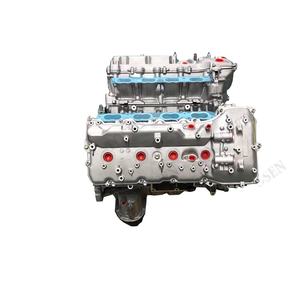Exactly how to Select the Right Opel Corsa Engine for Your Cars and truck
Exactly how to Select the Right Opel Corsa Engine for Your Cars and truck
Blog Article
Exploring the Inner Functions of a Compact Lorry's Engine System
As chauffeurs, we commonly take for granted the intricate processes that take place within the boundaries of our car's engine system. The compact yet intricate equipment that drives us ahead is a marvel of design accuracy and sychronisation. From the controlled explosions in the burning chamber to the thorough timing of fuel shot, every part plays a vital role in the smooth operation of the engine. In this exploration of a compact automobile's engine system, we will certainly untangle the internal operations of this mechanical symphony, clarifying the secrets that drive us ahead on our daily journeys.
Burning Process Review
The combustion process in a small car's engine system is a critical mechanism that effectively converts fuel into energy to power the car. This procedure takes place within the combustion chamber of the engine, where gas and air mix, ignite, and produce controlled surges. The burning process is composed of four primary phases: intake, exhaust, compression, and power.
During the consumption stage, the piston moves downward, attracting in a mix of air and gas right into the combustion chamber. The following stage, compression, involves the piston relocating upward, compressing the air-fuel mix to raise its strength. Subsequently, in the power phase, the ignition system ignites the compressed mix, causing a quick growth of gases that forces the piston back down. This downward movement produces the power required to drive the lorry. In the exhaust phase, the burned gases are expelled from the combustion chamber through the exhaust shutoff, preparing the chamber for the following cycle. This cyclic burning procedure is basic to the procedure of a portable automobile's engine system, making sure efficient energy conversion for propulsion.
Piston and Cyndrical Tube Interaction

The piston's accurate fit within the cyndrical tube is essential for preserving optimal compression and protecting against energy loss during combustion. Tight clearances between the piston and cyndrical tube walls ensure efficient securing, enabling the piston to relocate smoothly without permitting gases to leakage past. Appropriate lubrication is likewise essential to minimize rubbing and use in between these elements, boosting durability and performance.
Moreover, the layout and products used in manufacturing the piston and cylinder impact engine effectiveness and toughness. Modern engines frequently utilize light-weight yet resilient materials like aluminum alloys for pistons and cyndrical tube linings to minimize inertia and improve thermal efficiency. Generally, the unified communication between the piston and cyndrical tube is basic to the engine's capability and overall efficiency.
Gas Injection System Functionality
Fuel injection systems in compact vehicle engines play a crucial function in specifically providing fuel to the combustion chamber for regulated and reliable ignition. The gas injection system functions by infusing fuel into the combustion chamber at the ideal moment during the engine's operation (opel corsa engine). This accurate timing makes sure that the gas blends evenly with the air for appropriate combustion, resulting in enhanced gas performance and minimized emissions
There are mostly two kinds of gas injection systems utilized in small car engines: port fuel shot (PFI) and direct gas shot (DFI) PFI systems inject gas into the intake port before the intake valve, while DFI systems infuse fuel directly right into the combustion chamber. go to this site Both systems have their benefits, with DFI providing far better fuel atomization and PFI providing an extra cost-effective option.
Recognizing Engine Air Conditioning Systems
Efficient procedure of a portable automobile's engine counts greatly on the performance of its cooling devices. The cooling system in a portable vehicle generally consists of several components working with each other to control the engine temperature level. Understanding these engine cooling devices is important for keeping the performance and durability of a portable vehicle's engine system.

Exhaust System Elements Explained
The optimal functioning of a portable vehicle's engine cooling mechanisms depends on a complementary system recognized as the exhaust system, which consists of numerous crucial parts for ensuring effective exhausts and engine efficiency. The exhaust manifold collects exhaust gases from the engine's cyndrical tubes and courses them to the catalytic converter.
One critical component of the exhaust system is the oxygen sensing unit, which checks the oxygen degrees in the exhaust gases to help regulate gas consumption and ensure optimum engine performance. opel corsa engine. Furthermore, the resonator might exist in some exhaust systems to minimize sound degrees. Generally, the exhaust system plays a vital duty in preserving engine effectiveness, decreasing unsafe discharges, and making sure a quieter driving experience for portable click here now automobile owners

Final Thought
Finally, the compact automobile's engine system is an intricate mix of elements that interact to assist in the combustion process, transform fuel into power, and eliminate waste gases. Recognizing the inner operations of the engine system, consisting of the piston and cylinder communication, fuel injection system, engine cooling devices, and exhaust system components, is essential for preserving optimum efficiency and efficiency of the vehicle.
The combustion process in a compact automobile's engine system is a crucial system that successfully converts fuel into energy to power the car.Gas shot systems in small car engines play a critical duty in specifically supplying gas to the combustion chamber for regulated and effective ignition.There are mainly blog two kinds of gas injection systems used in portable vehicle engines: port fuel shot (PFI) and straight fuel shot (DFI) Understanding these engine air conditioning systems is vital for keeping the efficiency and longevity of a small car's engine system.
The optimal performance of a portable lorry's engine cooling mechanisms depends on a complementary system recognized as the exhaust system, which makes up numerous necessary parts for making sure efficient exhausts and engine performance.
Report this page